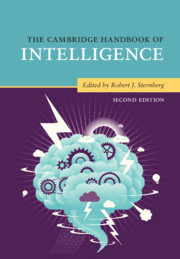Book contents
- The Cambridge Handbook of Intelligence
- The Cambridge Handbook of Intelligence
- Copyright page
- Dedication
- Contents
- Figures
- Tables
- Contributors
- Preface
- Part I Intelligence and Its Measurement
- Part II Development of Intelligence
- Part III Intelligence and Group Differences
- Part IV Biology of Intelligence
- 17 Animal Intelligence
- 18 The Evolution of Intelligence
- 19 The Biological Basis of Intelligence
- Part V Intelligence and Information Processing
- Part VI Kinds of Intelligence
- Part VII Intelligence and Its Role in Society
- Part VIII Intelligence and Allied Constructs
- Part IX Folk Conceptions of Intelligence
- Part X Conclusion
- Author Index
- Subject Index
- References
18 - The Evolution of Intelligence
Reconstructing the Pathway to the Human Mind
from Part IV - Biology of Intelligence
Published online by Cambridge University Press: 13 December 2019
- The Cambridge Handbook of Intelligence
- The Cambridge Handbook of Intelligence
- Copyright page
- Dedication
- Contents
- Figures
- Tables
- Contributors
- Preface
- Part I Intelligence and Its Measurement
- Part II Development of Intelligence
- Part III Intelligence and Group Differences
- Part IV Biology of Intelligence
- 17 Animal Intelligence
- 18 The Evolution of Intelligence
- 19 The Biological Basis of Intelligence
- Part V Intelligence and Information Processing
- Part VI Kinds of Intelligence
- Part VII Intelligence and Its Role in Society
- Part VIII Intelligence and Allied Constructs
- Part IX Folk Conceptions of Intelligence
- Part X Conclusion
- Author Index
- Subject Index
- References
Summary
Where did our intelligence come from? That is, what evolutionary drivers caused such specialization in cognition among humans? Only by adopting a comparative approach, considering the brains and cognitive skills of other animal species, can we discover how, when, and even perhaps why human intellectual skills evolved. Here we apply a process of evolutionary reconstruction to ancestors we share with other species, from the earliest primates at 74 Ma (million years ago) to the relatively recent ancestor shared with chimpanzees. Doing so highlights the importance of both social and ecological (nutritional) pressures in evolving intellect. Complex sociality was supported by increased perception, learning, and memory skills, long before the development of any ability to understand other beings as causal agents with independent minds. The latter, we argue, was driven by a need to feed more efficiently in ancestors we share with all living great apes.
Keywords
Information
- Type
- Chapter
- Information
- The Cambridge Handbook of Intelligence , pp. 428 - 450Publisher: Cambridge University PressPrint publication year: 2020
